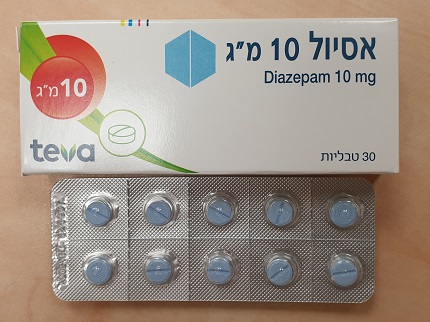Quest for the right Drug

אסיול 10 מ"ג ASSIVAL 10 MG (DIAZEPAM)
תרופה במרשם
תרופה בסל
נרקוטיקה
ציטוטוקסיקה
צורת מתן:
פומי : PER OS
צורת מינון:
טבליה : TABLETS
עלון לרופא
מינוניםPosology התוויות
Indications תופעות לוואי
Adverse reactions התוויות נגד
Contraindications אינטראקציות
Interactions מינון יתר
Overdose הריון/הנקה
Pregnancy & Lactation אוכלוסיות מיוחדות
Special populations תכונות פרמקולוגיות
Pharmacological properties מידע רוקחי
Pharmaceutical particulars אזהרת שימוש
Special Warning עלון לרופא
Physicians Leaflet
Pharmacological properties : תכונות פרמקולוגיות
Pharmacodynamic Properties
5.1. Pharmacodynamic properties ATC code: N05B A01 (anxiolytics, benzodiazepine derivatives) Diazepam is a benzodiazepine tranquillizer with anticonvulsant, sedative, hypnotic, muscle relaxant and amnesic properties. These are believed to act on specific receptors close to the GABA receptor where they facilitate its effects. The exact physiological role of GABA is not understood although it is known to be on an inhibitory transmitter which dampens neuronal activity in the brain. Benzodiazepines, such as diazepam, bind to receptors in various regions of the brain and spinal cord. This binding increases the inhibitory effects of gamma-aminobutyric acid (GABA). GABAs functions include CNS involvement in sleep induction. Also involved in the control of hypnosis, memory, anxiety, epilepsy and neuronal excitability. Diazepam is a long-acting benzodiazepine due to the formation of the long-lasting, pharmacologically active metabolite nordiazepam. Repeated doses may lead to accumulation of drug metabolites. The elderly and those with renal and/or hepatic impairment will be particularly susceptible to the adverse effects.
Pharmacokinetic Properties
5.2. Pharmacokinetic properties Absorption Diazepam is readily and completely absorbed from the GI tract. Peak plasma concentrations occurring within about 30-90 minutes of oral administration, a steady plasma concentration is reached after 5-6 days and is directly related to dose. Distribution Diazepam has a mean volume of distribution of 0.7 L/Kg (Range 0.18- 1.30L/Kg). Diazepam crosses the blood-brain barrier and is highly lipid soluble, this causes the initial effects to decrease rapidly as it is redistributed into fat deposits and tissues. The drug is highly plasma protein bound in the range 98-100%. Diazepam and its metabolites also enter breast milk and cross the placenta freely, this may lead to accumulation in the infant or fetus. Metabolism Diazepam is extensively metabolised in the liver and, in addition to desmethyldiazepam, its active metabolites include oxazepam and temazepam. Diazepam has a half-life of between 20-42 hours (Mean 30 hours). Diazepam has a biphasic half-life with an initial rapid distribution phase followed by a prolonged terminal elimination phase of 1 or 2 days; its action is further prolonged by the even longer half-life of 2-5 days of its principle active metabolite, desmethyldiazepam (nordiazepam), the relative proportion of which increases in the body on long-term administration. The plasma half-life of diazepam is prolonged in neonates, in the elderly, and in patients with kidney or liver disease. Elimination It is excreted in the urine, mainly in the form of its metabolites, either free or in conjugated form.

שימוש לפי פנקס קופ''ח כללית 1994
Anxiety & tension, neurotic states, skeletal muscle spasm
תאריך הכללה מקורי בסל
01/01/1995
הגבלות
תרופה שאושרה לשימוש כללי בקופ'ח
מידע נוסף
עלון מידע לצרכן
19.07.21 - עלון לצרכן אנגלית 19.07.21 - עלון לצרכן עברית 19.07.21 - עלון לצרכן ערבית 08.06.23 - עלון לצרכן עברית 27.10.23 - עלון לצרכן אנגלית 27.10.23 - עלון לצרכן עברית 27.10.23 - עלון לצרכן ערבית 07.01.21 - החמרה לעלון 07.01.21 - החמרה לעלון 11.01.21 - החמרה לעלון 19.07.21 - החמרה לעלון 08.06.23 - החמרה לעלוןלתרופה במאגר משרד הבריאות
אסיול 10 מ"ג